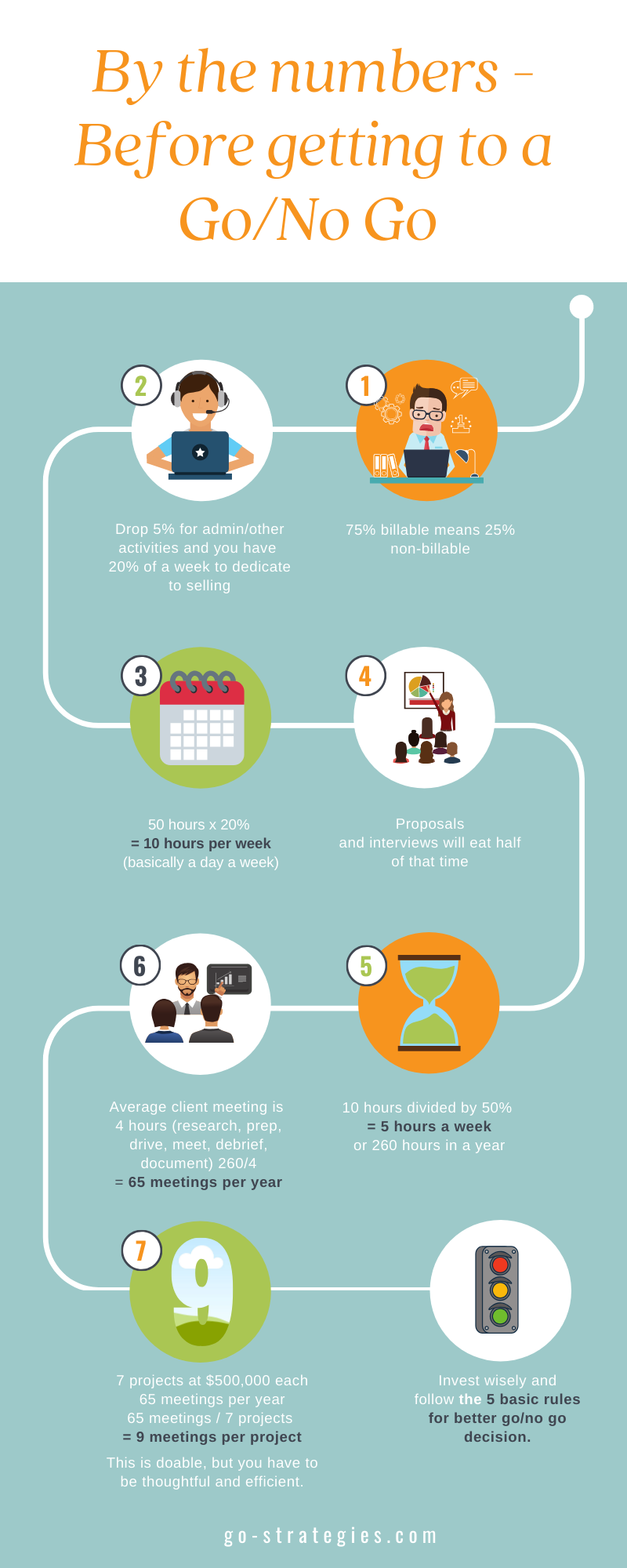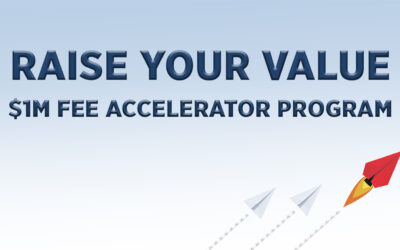We fixate on go/no go in this industry. As we should. Go/no go is the pivotal decision point in A/E/C consulting firms’ business where we consider ‘spending or not spending’ our precious overhead dollars to pursue work. It is an important marketing and business expenditure that gives us tangible results like proposals and interviews. In many cases, it is the one place where we burn the most overhead dollars for the fewest, but highest-valued returns: wins. Here are five basic rules and questions to ask for better go/no go decision-making.
1. Be ALL In.
Are you ALL in it to win it? Mentally, we are wired to believe we can do anything and sometimes we can climb seemingly impossible mountains. The whole team must recognize and share the ‘fire in the belly’—the passion and inner drive to take action—when pursuing the win. If everyone from leadership to seller/doer, PM to marketing professional has the fire, then: GO. If even one person has reservations about getting to the top of the mountain, you will likely not get to the top: NO GO.
2. Understand the investment.
Is the investment worth it? These are overhead dollars—if you spend them on pursuits, you have less for everything else overhead. Even if your staff works ‘on their own time’ to get the proposal out the door, there is a heavy cost in terms of employee satisfaction, burnout, and quality of work for deliverables. Every hour, regardless of whether it is a paid hour or not, must be tracked to accurately determine how these investments impact your bottom line.
3. Know your audience.
Do you know at least five selection committee members? Yes, five. And yes, I mean know them – played a round of golf, met them once at a conference, and read their LinkedIn profile is not knowing them. In many cases, selection committees are unknown, so you have to cast a wide net with your client engagement process. If the US Army Corps, District X, is reviewing your SF330, then you need to know 15 or 20 people there. You better be actively engaged in the Society of American Military Engineers (SAME) and take every opportunity to volunteer where they volunteer. You should be meeting with them all, at every opportunity you can find.
4. Know the project.
Why are they doing this project? How will it operate? What exactly are they building? How much money will they spend on it? Every project has dozens of hours of planning, conceptual design, and thought behind it. Most of the time, the initial project hours will be boiled down to a couple of pages (if we are lucky) in the Request for Proposal (RFP) description. If you do not have hours of intelligence gathering on the project, NO GO it. Your competitors do.
5. Know your strengths and weaknesses.
How will you really stack-up against the competition? Join professional organizations with your consulting and contracting peers. You will learn about your competition, teaming partners, and yourselves. In your proposals, as surprising as this may sound, start with the facts. For projects, focus on truly relevant, similar endeavors; the ones where you don’t have to stretch. Include only highly qualified staff; the people you know can deliver the work because you have experienced them delivering great work. Hoping does not earn the precious proposal points; only the tangible, quantifiable facts do.

These are just five basics rules. There are a million more out there. This is go/no go. This is valuable money being spent, in measurable and immeasurable ways. Are you spending it wisely? Please comment and add yours to this string.
About the authors:
Kathryn Ness, CPSM, is a partner in GO Strategies and brings an energy and vitality to the team that significantly promotes the mission of “making everything about marketing and business development easier.” With more than 20 years in the A/E/C industry, Kathryn brings an in-the-trenches perspective for how things work and, more importantly, how things can work better. She has held marketing and business development positions at small, medium, and large firms. Kathryn brings a professional, direct communication style that cuts through endless meetings and discussions and keeps teams on-point. Her sense of humor is balanced with a sense of getting-the-job done. She is an excellent listener and provides creative solutions that work, not abstract theory that sits on shelves.
Frank Lippert, FSMPS, CPSM, is the founder of Go Strategies. He provides strategic pursuit planning, strategic market capture planning, and the creative design and implementation of business development processes to clients throughout the US. Frank is all about helping teams work more effectively and more efficiently with processes, schedules, and tools that keep A/E/C firms’ business development strategy and marketing efforts on track. A good strategy and a focused approach to winning work with your target clients can save time and money, ease frustration, and lead to a happier workplace. Good, healthy, well-thought-out marketing practices lead to better team engagement, long-term marketing staff happiness, and more wins.
JOIN THE RAISE YOUR VALUE AUDIOBOOK LAUNCH TEAM
Help us get the audiobook off the ground and you'll receive the following benefits:
- Be among the first to hear the audiobook and give feedback
- Invitation for you and your leadership team to attend an exclusive web training to learn and discuss how to implement the 5-Step RAISE Your Value Formula in your firm
- Up to 20% discount on the RAISE Your Value online workshops for 12 months
- Corporate discounts on bulk orders of books
- Exclusive invitation to join us for our RAISE Your Value Audiobook Virtual Launch Party!
- Invitations to participate in other live and virtual events, workshops, book signings and other educational opportunities
More From the Find the Lost Dollars Blog...
5 TOP BUSINESS CHALLENGES A&E FIRMS FACE IN 2024
The business environment for A&E firm is changing due to growing competition, fee pressure, technology advances and hybrid work arrangements. Most A&E firms struggle to adapt to the fast pace of change. In working with A&E firms of every size and...
Increase Revenue with no Extra Work in 12 Months: The RAISE Your Value Fee Accelerator Program
We are excited to announce the launch of our new program – the RAISE Your Value $1M Fee Accelerator kicking off in January. This blog post will provide information about the program, the results you can expect to achieve and how you can be one of a small group of...
Strategic Advantage: Harnessing the VQ Assessment for A&E Excellence
In today's competitive landscape, architecture and engineering (A&E) firms face numerous challenges when it comes to differentiating themselves, maintaining profitability, and cultivating a company culture that truly embodies their values. In my newest book, RAISE...




